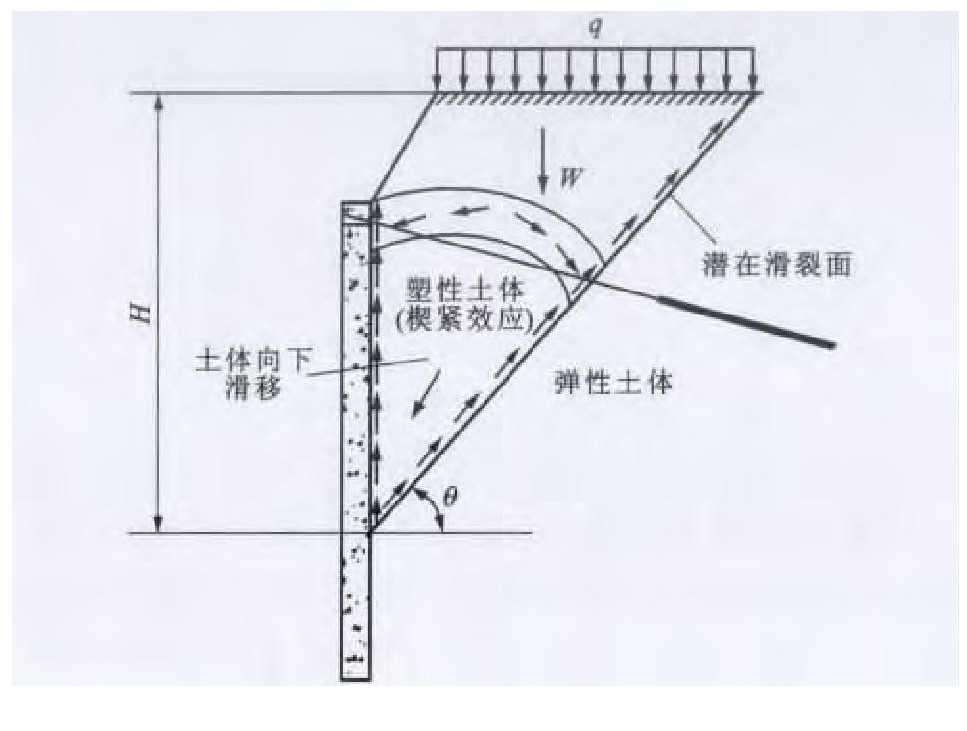Vertical soil arch effect analysis and soil pressure calculation behind piles for pile-anchor supporting system
Article Text (Baidu Translation)
-
摘要: 针对桩锚支护桩后竖向土拱效应, 利用土拱力学平衡条件分析了土拱的形成机理、几何特性与其对土体应力分布的影响。采用室内模型试验, 监测得到不同阶段下土体的应力场分布, 通过与现场监测数据和经典理论计算值的比较, 验证竖向土拱的存在。基于竖向土拱效应, 采用斜土层单元法, 推导了桩后土体应力分布表达式, 并与经典理论计算值和模型试验数据进行了对比分析。研究结果表明: 土体自重应力曲线在2层锚杆间发生衰减, 桩侧土压力在锚杆支点处出现相对峰值, 锚杆上部形成了竖向土拱, 对土体应力重分布影响显著。采用考虑竖向土拱效应的斜土层单元法得到的土压力分布规律与室内试验结果一致, 2条曲线同深度处桩侧土压力最大差值不超过15%, 表明利用该方法计算出的土压力具有较高的准确性。Abstract: Aimed at the vertical soil arch effect of pile-anchor retaining structure, the formation mechanism and geometric characteristics of vertical soil arch and its influence on soil stress distribution were analyzed by using the mechanical equilibrium condition of soil arch.In indoor model test, soil stress field distributions at different excavation stages were obtained by monitoring.The existence of vertical soil arch was proved by comparing the test data, the monitoring data and the theoretical values.Based on the vertical soil arch effect, the expressions of soil stress distribution behind pile were derived by adopting the oblique soil element method, and the computed values were analyzed based on the classic theory computation values and the test data.Study result shows that the gravity stress curve of soil attenuates between anchors.There are relative peaks on lateral stress curve at anchor supporting point behind pile.Vertical soil arch appears above the bolts, and has significant effect on soil stress redistribution.The soil pressure distribution law calculated by the oblique soil element method considering vertical soil arch effect is consistent with the test result, the biggest soil pressure difference at the same depth of two curves is less than 15%, which proves that the calculating method of soil pressure is accurate.
-
表 1 土压力合力与作用点比较
Table 1. Comparison of resultant soil pressures and action points

-
[1] TANG Yu-geng, KUNG G T C. Application of nonlinear optimization technique to back analyses of deep excavation[J]. Computers and Geotechnics, 2009, 36 (1/2): 276-290. [2] 马平, 秦四清, 张勇, 等. 深基坑桩锚支护体系主动区土压力试验研究[J]. 工程地质学报, 2006, 14 (2): 245-248. doi: 10.3969/j.issn.1004-9665.2006.02.018MA Ping, QIN Si-qing, ZHANG Yong, et al. In-situ test on active earth pressure zone in piles and anchor supporting system for deep foundation pit[J]. Journal of Engineering Geology, 2006, 14 (2): 245-248. (in Chinese). doi: 10.3969/j.issn.1004-9665.2006.02.018 [3] 李成芳, 叶晓明, 李有文. 考虑土拱效应预应力锚拉桩土压力研究[J]. 岩土力学, 2011, 32 (6): 1683-1689. doi: 10.3969/j.issn.1000-7598.2011.06.015LI Cheng-fang, YE Xiao-ming, LI You-wen. Study of earth pressure of prestressed anchor pile considering soil arching[J]. Rock and Soil Mechanics, 2011, 32 (6): 1683-1689. (in Chinese). doi: 10.3969/j.issn.1000-7598.2011.06.015 [4] 刘忠玉, 马德遂, 何盛东. 层状填土的主动土压力计算[J]. 郑州大学学报: 工学版, 2004, 25 (3): 56-59. doi: 10.3969/j.issn.1671-6833.2004.03.014LIU Zhong-yu, MA De-sui, HE Sheng-dong. Active earth pressure acting on retaining walls with layered backfills[J]. Journal of Zhengzhou University: Engineering Science, 2004, 25 (3): 56-59. (in Chinese). doi: 10.3969/j.issn.1671-6833.2004.03.014 [5] SALMAN1FA, AL-SHAKARCHI Y J, HUSAIN H M, et al. Distribution of earth pressure behind retaining walls considering different approaches[J]. International Journal of the Physical Sciences, 2010, 5 (9): 1389-1400. [6] 章瑞文, 徐日庆, 郭印. 考虑挡土墙墙体平移的墙后分层填土主动土压力分布[J]. 水利学报, 2008, 39 (2): 250-255. doi: 10.3321/j.issn:0559-9350.2008.02.021ZHANG Rui-wen, XU Ri-qing, GUO Yin. Distribution of active earth pressure acting on retaining walls with soil placed in layers and considering the displacement of wall[J]. Journal of Hydraulic Engineering, 2008, 39 (2): 250-255. (in Chinese). doi: 10.3321/j.issn:0559-9350.2008.02.021 [7] BOLTON M D, STEEDMAN R S. The behavior of fixed cantilever walls subject to lateral shaking[C]∥TRB. Proceedings of a Symposium on the Application of Centrifuge Modelling to Geotechnical Design. Manchester: TRB, 1985: 301-313. [8] 周健, 张刚, 曾庆有. 主动侧向受荷桩模型试验与颗粒流数值模拟研究[J]. 岩土工程学报, 2007, 29 (5): 650-656. doi: 10.3321/j.issn:1000-4548.2007.05.004ZHOU Jian, ZHANG Gang, ZENG Qing-you. Model tests and PFC2Dnumerical analysis of active laterally loaded piles[J]. Chinese Journal of Geotechnical Engineering, 2007, 29 (5): 650-656. (in Chinese). doi: 10.3321/j.issn:1000-4548.2007.05.004 [9] DANNO K, KIMURA M. Evaluation of long-term displacements of pile foundation using coupled FEM and centrifuge model test[J]. Soils and Foundations, 2009, 49 (6): 941-958. doi: 10.3208/sandf.49.941 [10] 陈锦剑, 吴琼, 王建华, 等. 开挖卸荷条件下单桩承载力特性的模型试验研究[J]. 岩土工程学报, 2010, 32 (增2): 85-88. https://www.cnki.com.cn/Article/CJFDTOTAL-YTGC2010S2023.htmCHEN Jin-jian, WU Qiong, WANG Jian-hua, et al. Model tests on bearing capacity of single pile influenced by excavation[J]. Chinese Journal of Geotechnical Engineering, 2010, 32 (S2): 85-88. (in Chinese). https://www.cnki.com.cn/Article/CJFDTOTAL-YTGC2010S2023.htm [11] 吕庆, 孙红月, 尚岳全. 抗滑桩桩后土拱效应的作用机理及发育规律[J]. 水利学报, 2010, 41 (4): 471-476. https://www.cnki.com.cn/Article/CJFDTOTAL-SLXB201004014.htmLU Qing, SUN Hong-yue, SHANG Yue-quan. Mechanism and development law of soil arch effect behind anti-slide piles[J]. Journal of Hydraulic Engineering, 2010, 41 (4): 471-476. (in Chinese). https://www.cnki.com.cn/Article/CJFDTOTAL-SLXB201004014.htm [12] 向先超, 张华, 蒋国盛, 等. 基于颗粒流的抗滑桩土拱效应研究[J]. 岩土工程学报, 2011, 33 (3): 386-391. https://www.cnki.com.cn/Article/CJFDTOTAL-YTGC201103015.htmXIANG Xian-chao, ZHANG Hua, JIANG Guo-sheng, et al. Soil arching effect of anti-slide piles based on particle flow method[J]. Chinese Journal of Geotechnical Engineering, 2011, 33 (3): 386-391. (in Chinese). https://www.cnki.com.cn/Article/CJFDTOTAL-YTGC201103015.htm [13] ESKISAR T, OTANI J, HIRONAKA J. Visualization of soil arching on reinforced embankment with rigid pile foundation using X-ray CT[J]. Geotextiles and Geomembranes, 2012, 32 (1): 44-54. [14] 蒋良潍, 黄润秋, 蒋忠信. 黏性土桩间土拱效应计算与桩间距分析[J]. 岩土力学, 2006, 27 (3): 445-450. doi: 10.3969/j.issn.1000-7598.2006.03.021JIANG Liang-wei, HUANG Run-qiu, JIANG Zhong-xin. Analysis of soil arching effect between adjacent piles and their spacing in cohesive soil[J]. Rock and Soil Mechanics, 2006, 27 (3): 445-450. (in Chinese). doi: 10.3969/j.issn.1000-7598.2006.03.021 [15] LI S J, CHEN J, FENG X T. Analytic solution to soil arching effect and its application based on interaction of slope soil and piles[J]. Materials Research Innovations, 2011, 15 (S1): 578-581. [16] 赵恒惠. 挡土墙后粘性填土的土压力计算[J]. 岩土工程学报, 1983, 5 (1): 134-146. doi: 10.3321/j.issn:1000-4548.1983.01.012ZHAO Heng-hui. The computation of earth pressure of cohesive backfill on retaining wall[J]. Chinese Journal of Geotechnical Engineering, 1983, 5 (1): 134-146. (in Chinese). doi: 10.3321/j.issn:1000-4548.1983.01.012 -





 下载:
下载:


















